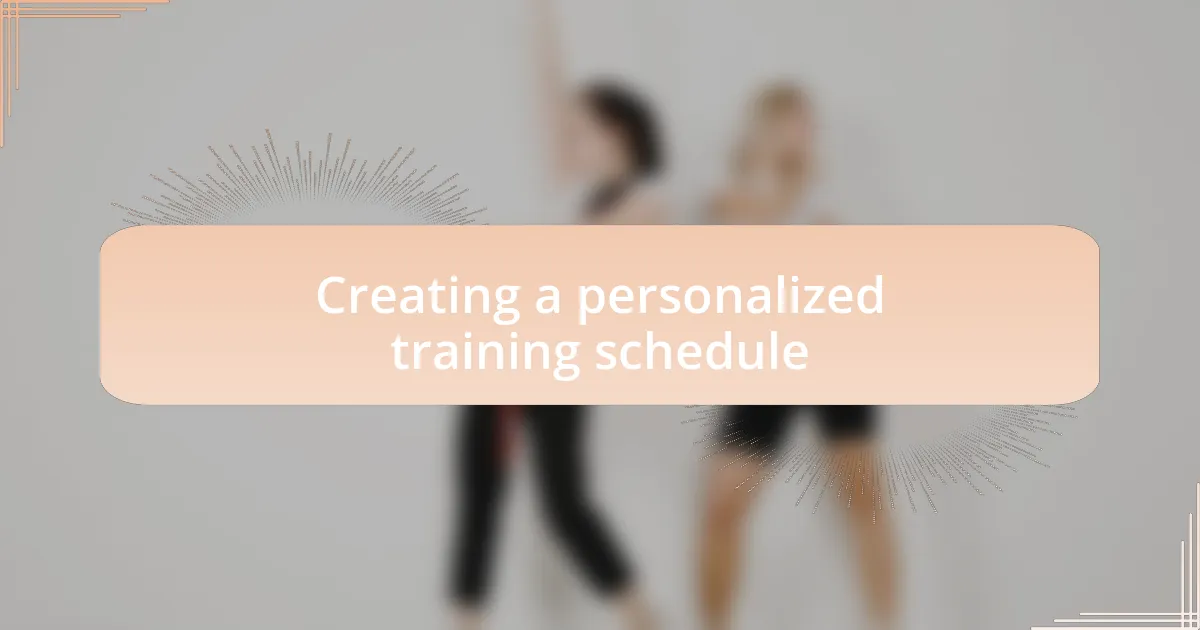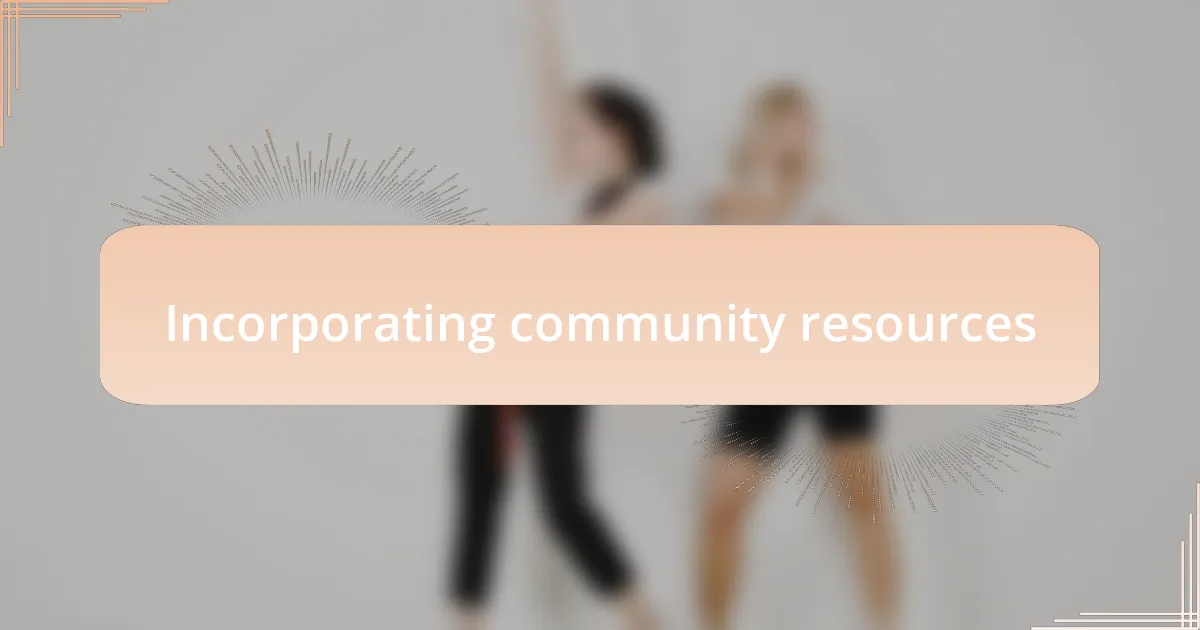Key takeaways:
- Understanding breakdancing fundamentals is crucial, focusing on body control, footwork, and musical connection to express oneself through dance.
- Creating a personalized training schedule enhances progress, allowing for focused skill development and flexibility to prevent burnout.
- Utilizing community resources such as workshops, online forums, and local studios enriches the learning experience and fosters a sense of collaboration.
- Developing a self-evaluation routine, including video reviews and peer feedback, is essential for recognizing growth and identifying areas for improvement.

Understanding breakdancing fundamentals
When I first stepped onto the floor, I quickly realized that understanding the fundamentals of breakdancing is like learning a new language. Each move has its own dictionary, from the foundational top rock to the explosive power moves. It’s fascinating how the rhythm of music can dictate the flow of your body, and I often found myself getting lost in the beat while practicing.
One of the most surprising elements for me was learning how important body control is in breakdancing. It’s not just about executing flashy moves; it’s about mastering the basics like footwork and balance. I still remember the day I finally nailed my six-step—it felt like unlocking a new level in a video game. Can you recall a moment when you perfected a move after weeks of trying? That rush of achievement makes every moment spent on the floor worth it.
I’ve discovered that footwork isn’t just a series of steps; it tells a story. It allows you to express yourself while connecting to the music and the audience. Every time I practice, I think about how each transition flows into the next, creating a seamless dance narrative. What do you want your footwork to say? Embracing these fundamentals not only strengthens your technique but also deepens your connection to the art of breakdancing.

Creating a personalized training schedule
Creating a personalized training schedule can make a world of difference in your breakdancing journey. I remember when I first started; I would jump into practice without a clear plan. Over time, I learned that dedicating specific days to focus on different skills—like power moves versus footwork—allowed me to track my progress and address my weaknesses more effectively. Have you noticed how having a structured approach makes your practice feel purposeful?
In developing my schedule, I also incorporated flexibility to adapt to my energy levels and daily commitments. There were weeks when I felt physically drained or uninspired, and during those times, I would focus on lighter sessions, such as stretching or watching tutorials to spark creativity. This adaptability kept me from burning out, ensuring I remained excited about hitting the floor. How do you balance your energy while practicing?
Finally, I found that incorporating rest days into my routine was essential. Breakdancing demands a lot from your body, and without proper recovery, progress can stall. On my rest days, I often reflect on what I’ve learned and envision the new moves I want to tackle next. This mental preparation has helped me maintain a strong mindset and a clear vision for my training. What strategies do you use to keep your motivation high during down times?

Incorporating community resources
Utilizing community resources can genuinely enrich your training experience. I recall attending a few local workshops that brought invaluable insights from seasoned dancers. Being in a space where we exchanged tips and styles helped me learn not just through instruction but through the energy and creativity of others. Have you ever had a breakthrough moment at a community event?
Another great resource is online forums or social media groups dedicated to breakdancing. I often find myself scrolling through videos and discussions where dancers share their challenges and victories. Connecting with people who face similar hurdles can make the journey feel less solitary and more collaborative. How often do you engage with the wider breakdancing community online?
Additionally, reaching out to local dance studios for open practice sessions can be a game changer. I remember when I first started, finding a studio offering open floor time was like discovering a treasure. It provided a chance to practice in a supportive environment while also meeting new friends who shared my passion. Do you take advantage of local spaces to refine your skills?

Developing a self-evaluation routine
Developing a self-evaluation routine is essential for anyone serious about improving their breakdancing skills. Personally, I like to set aside specific time each week to reflect on my progress. I jot down what moves felt strong, which ones I struggled with, and any moments that really challenged me. Have you ever paused to recognize how far you’ve come?
One effective method I’ve used is video recording my practice sessions. Watching myself dance not only reveals nuances I might miss in the moment, but it also helps me appreciate my growth over time. I’ll often capture a particularly good session or a technique I want to refine, and then review those clips with a critical eye. Are you brave enough to film your own sessions?
To keep things dynamic, I incorporate feedback from friends and fellow dancers in my self-evaluation process. When I get their insights, it often opens my eyes to areas of improvement I hadn’t considered before. I once had a friend point out how my transitions could flow better, which sparked a whole new focus for me. How do you involve others in shaping your personal journey?

Finding online tutorials and classes
Finding online tutorials and classes has become a game-changer for many breakdancers, especially those like me who thrive on visual learning. I remember stumbling upon a YouTube channel dedicated to breakdancing techniques, and it felt like opening a treasure chest. Watching experienced dancers break down complex moves step by step truly made it easier for me to grasp the nuances of each technique. Have you explored the vast resources available online?
Beyond YouTube, there are specialized platforms that offer comprehensive breakdancing courses tailored for various skill levels. I enrolled in an online class that not only provided instructional videos but also allowed for interaction with instructors and peer feedback. The community aspect was invaluable; sharing progress and receiving tips from others inspired me to push past my limits. Have you found a community that challenges and encourages you in your practice?
Don’t underestimate the power of social media, as platforms like TikTok and Instagram can also be fantastic for discovering quick tutorials and innovative moves. I’ve often found myself practicing along with brief clips shared by other dancers, which adds a layer of fun to my routine. The creativity flowing through these platforms is infectious—who knows, you might even find yourself inspired to try something completely new! What’s stopping you from diving into these endless online possibilities?

Connecting with local breakdancing groups
Connecting with local breakdancing groups can really elevate your practice. I remember the first time I attended a local jam; the energy was electric. It was incredible to watch dancers push their boundaries and encourage one another. Have you ever felt that rush of adrenaline when you’re surrounded by fellow enthusiasts, all sharing the same passion?
Building connections within your community can open doors to collaborative sessions and workshops. I joined a breakdancing crew that met every weekend to train together. Those sessions were not just about improving our skills; they fostered friendships that extended beyond the dance floor. Isn’t it amazing how a shared interest can bring together people from diverse backgrounds?
Don’t hesitate to reach out to local dance studios or community centers that host breakdancing events. I discovered that many places offer open sessions where dancers can share tips and tricks. Participating in these gatherings can create a supportive network, motivating you to keep pushing your limits. How might your breakdancing journey change if you had a crew cheering you on?